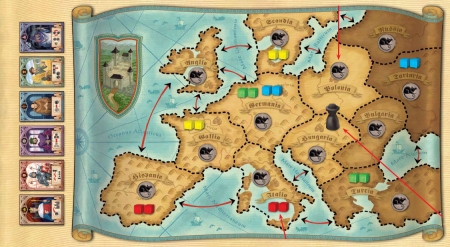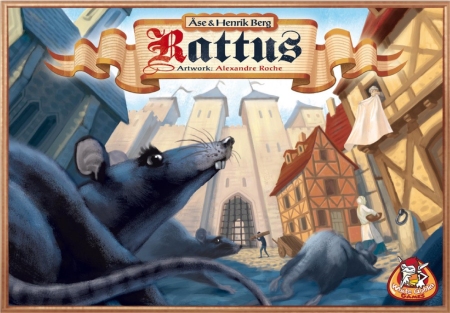Review: Rattus
Posted by James (admin) on March 28th, 2010
 Rattus is by the same designers who created Oregon, one of my favourite board games. For me, Oregon has a great mix of strategy and planning without being heavy – plenty to think about, a good amount of control, but relatively light so most people can enjoy it. So, I was really pleased when I heard they had created a new game.
Rattus is by the same designers who created Oregon, one of my favourite board games. For me, Oregon has a great mix of strategy and planning without being heavy – plenty to think about, a good amount of control, but relatively light so most people can enjoy it. So, I was really pleased when I heard they had created a new game.
Rattus is themed around the Black Death, the plague that wiped out 1/3 of the European population from 1348-1350. In essence, players take turns placing their population (coloured cubes) onto the European map and, as you may expect, population pieces get removed as the plague sweeps from area to area. The winner is the player with the most population left at the end of the game.
Three items need to be mention before describing how the game works: First, plague is represented by plague disks which remain face-down until plague is triggered. When revealed, they show which and whose population cubes get removed from the area. Second, the plague piece (a suitably black pawn) shows where the next breakout might occur, and this is moved every turn. Third, 6 class cards (Knight, Peasant, Monk, Merchant, King and Witch) each giving its owner a special power.
On their turn, a player can choose take a single class (role) if they want. As there is only one card for each class, they take this from the current owner if it is already owned. This is the only way a player can get rid of a class they have previously taken, and you’ll see why having lots of classes is likely to be a bad thing a bit later. Then, the player must place some of their population cubes onto the board. They place as many cubes into an area as there are plague discs (max. number of plague discs in an area is 3). During this, the player can use as many of the powers of the classes they own as they want.
To finish their turn, the player executes the plague’s phase. The player must move the plague piece to a region neighbouring its current location. If the plague piece’s new location contains one plague disc, the player places one new plague disc into a neighbouring region. If the plague piece’s new location contains two or more plague discs, they place two new discs. Finally, if there is at least one plague disc and at least one population cube in the plague piece’s area, plague breaks out and must be resolved.
To resolve a breakout, plague discs in the affected area are turned over one-by-one until either no more plague discs or no more population remain. When revealed, the plague discs show a number which is the minimum population required to trigger the disc, i.e. 3+ means this disc triggers if there are 3 or more population cubes in the area. The plague disc also shows some symbols. Most symbols match the different classes. A player who owns the class that the symbol shows loses one population cube in the affected area. There are also two other symbols: M means the player(s) with the majority of population markers loses a cube, and A means all players with population markers lose a cube each. So, if you have a lot of the class cards in front of you, you are more likely to be affected by an outbreak.
The powers the player can use for each class are nicely different. The peasant lets you add one additional population cube; the knight lets you move the plague piece an extra space; the witch lets you examine two plague discs and (optionally) swap their locations; the merchant lets you move up to 3 of your population cubes to a neighbouring region; the monk lets you move a plague marker to a neighbouring area, and, finally, the king lets you move a population cube from a plague disc free area to the Castle (which is totally safe from plague).
The game ends when there are no more plague discs to add to the board, or when a player has all of their population cubes on the board (good luck with the latter). All areas have their plague discs resolved in a final sweep of plague breakouts. The player with the most population markers on the board wins (ties split by turn order).
I should point out the game board scales depending upon the players as some areas are not used in a 3-player game and some more are not used in a 2-player game.
 Overall, I think Rattus is a really good, light Euro game. It plays very quickly and is relatively simple. With the full 4-players a lot can happen between turns, so you can plan your moves ahead but you often need to think on your feet too. The class powers are meant to be tempting, although it is tempting not to take any powers at all; however, I am pleased to say that the winners of both of my games were not the players that avoided owning class cards. Working out which class cards a following player would quickly take off your hands was important. Also, using multiple class powers together can be really effective but needs a bit of planning as you can only acquire one new class each turn plus it increases your risk of suffering losses when plague breaks out.
Overall, I think Rattus is a really good, light Euro game. It plays very quickly and is relatively simple. With the full 4-players a lot can happen between turns, so you can plan your moves ahead but you often need to think on your feet too. The class powers are meant to be tempting, although it is tempting not to take any powers at all; however, I am pleased to say that the winners of both of my games were not the players that avoided owning class cards. Working out which class cards a following player would quickly take off your hands was important. Also, using multiple class powers together can be really effective but needs a bit of planning as you can only acquire one new class each turn plus it increases your risk of suffering losses when plague breaks out.
I think Rattus has more to think about than first meets the eye too. Players can attempt to trigger plague in specific areas where they have population when the total population in that area is still low, so the chances of plague discs taking effect is lower. Also, the number and mix of cubes in an area offers much consideration – it can be worth having lots of cubes in a single area if all players have a presence too, especially if you have fewer classes. Controlling the location of the plague piece is also a very important factor as plague can not strike without the plague piece. One part of the game that really appeals is that players are always moving the plague piece to try and harm other players. This indirect attacking of other players isn’t confrontational so has a nice humour about it.
I think it may be even more interesting if the players started the game with a class each. This would get the ball rolling a bit quicker as some groups may be reluctant to take classes early on which could be less interesting.
Rattus can be played quickly, downtime is minimal, the game contains interesting decisions and planning, plus it can have some very humourous moments when a particular plague disc is just the right one to wipe out loads of population cubes (so long as they’re not your cubes). Really enjoyable and I am looking forwards to trying it 2-player.
James.
[Played with 4 experienced gamers, and again with 4 inexperienced gamers]


April 1st, 2010 at 2:28 am
Thanks for this review. This is really well-written. I feel like I understand the game well enough to start playing. However, I don’t think I want really want to. Your reference to Oregon, on the other hand, makes me want to get a copy of it.
April 3rd, 2010 at 12:51 am
Thanks, Jacob. Rattus is quite different to Oregon – I think it’s definitely lighter than Oregon – but is worth trying if you like light Eurogames.